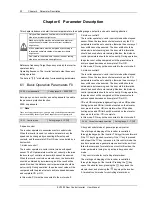
36 Chapter 6 Parameter Description
EV3200 Door Control Inverter User Manual
Defines the data format adopted in CAN communication
protocol.
0: 10kbps
1: 20kbps
2: 40kbps
3: 80kbps
4: 125kbps
F8.07 CAN communication
failure detection time
Setting range: 0, 0.1 ~ 100.0s
【
0
】
If communication control mode is not selected (F0.02=0 ~ 2
or F0.02=4 ~ 5), this function is disabled.
When F8.07=0, this function is disabled.
When F8.07 is not set to 0, if the communication interrupt
lasts longer than the setting of F8.07, fault code E017
(communication error) will be displayed, and the inverter will
stop.
F8.08 CAN communication
delay
Setting range: 0.01 ~ 1.000s
【
0.01
】
You may define the response delay of the inverter in
communication according to the speed of the CAN main
station. The contents of the CAN communication protocol
can be modified according to your requirement.
6.10 Monitoring And Recording
Parameters F9
F9.00 Parameters displayed
by LED
Setting range: 1 ~ 1023
【
31
】
F9.00 is to set the parameters that can be displayed on LED.
For parameters that have been selected, you may scroll
through them by pressing
on the keypad.
The display of each parameter is controlled by a binary bit,
"1" for display, "0" for not display. Therefore whether these
10 parameters can be displayed is determined by 10-bit
binary code. For example, Bit 0 controls whether to display
operating frequency, if Bit 0=0, the frequency will not be
displayed, if Bit 0=1, the frequency will be displayed. The
representation of each bit is shown below:
Bit 0: running frequency (Hz)
Bit1: reference frequency (Hz)
Bit 2: output voltage (V)
Bit 3: output current (A)
Bit 4: output torque (%)
Bit 5: DC bus voltage (V)
Bit 6: Status of input terminal (No unit)
Note
Terminal input status is represented by a 10-bit binary code. Each
bit represents ON/OFF state of an input terminal. The bit is "1" if
the inverter detects the terminal is on, and is "0" if the inverter
detects the terminal is off. We define the relation of bits and
terminals as follows:
Bit
bit6
bit5
bit4 bit3 bit2
bit1
bit0
Input terminal
CD
OD
X5 X4 X3
X2
X1
The number displayed by LED is the decimal number of the
corresponding binary code.
Bit 7: Status of output terminal (no unit)
Note
Terminal input status is represented by a 4-bit binary code. Each
bit represents ON/OFF state of an input terminal. The bit is "1" if
the inverter detects the terminal is activated, and is "0" if the
inverter detects the terminal is not activated. We define the
relationship of bits of the binary code and terminals as follows:
Bit
bit2 bit1 bit0
Output terminal
PA3/PB3/PC3 PA2/PC2 PA1/PC1
The number displayed by LED is the decimal number of the
corresponding binary code.
Bit 8: Low digits of pulse of door position (0 ~ 9999)
Bit 9: High digits of pulse of door position (0 ~ 9999)
Note
Door position = High digits of pulse counted for door position
×
10000+low digits of pulse counted for door position
How to set the values
To determine what you want to display first and then set the
corresponding bit to "1". For example, if you need to
display the corresponding parameters controlled by Bit 0 ~
Bit 4, and not display other parameter, the setting should be
0000011111.
·
To convert the binary code into the decimal code, the
calculation formula is:
i=0
7
bit
i
· 2
i
, where, i: 0 ~ 9.
As mentioned above, to convert the binary code into
decimal code: 1 × 2
0
+1 × 2
1
+1 × 2
2
+1 × 2
3
+1 × 2
4
= 31
Therefore, this parameter is set to 31.
F9.01 Selection of parameters
displayed by LED in stopping status
Setting range: 0 ~ 6
【
0
】
0: Preset OD frequency (Hz)
1: Preset CD frequency (Hz)
2: Status of input terminal (No unit)
3: Status of output terminal (No unit)
4: DC bus voltage (V)
5: Low digits of pulse counted for door position (0 ~ 9999)
6: High digits of pulse counted for door position (0 ~ 9999)
Door position = High digits of pulse counted for door
position × 10000+ Low digits of pulse counted for door
position






























